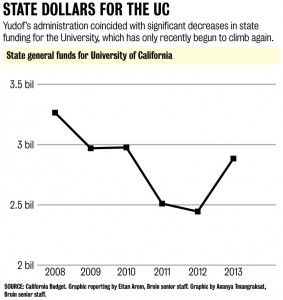 I arrived at UCLA in 2012 with the campus still furious about the recent tuition increases. But despite the uproar among students about skyrocketing college payments, my tuition and student fees – just like those of many others – were covered by the University.
I arrived at UCLA in 2012 with the campus still furious about the recent tuition increases. But despite the uproar among students about skyrocketing college payments, my tuition and student fees – just like those of many others – were covered by the University.
As University of California President Mark Yudof yields the stage to incoming president and former U.S. Cabinet secretary Janet Napolitano, it is easy to remember his time at the head of the system solely as one of budget-slashing and escalating fees.
However, when we measure the success of Yudof’s presidency, it is important to understand and acknowledge the administration’s efforts to combat a difficult set of circumstances.
As tuition hikes piled up and higher education at California’s premier university system appeared increasingly out of reach for many Californians, Yudof’s administration put in new aid programs for students such as myself, and allowed me to benefit from a UC education without paying a dollar for tuition.
Despite $900 million in cuts from state funding to the UC over the past five years, Yudof’s administration still implemented scholarship programs such as the Blue and Gold Opportunity Plan, relieving financial stress for lower- and middle-income students.
The plan allows students with family income in the lower ranges – the students affected most dramatically by tuition hikes – to obtain a UC education, with their academic and student fees covered through grants and scholarships.
During the 2010-2011 academic year, more than half of UC undergraduate students received assistance from the plan.
Students received an average of $14,514 in grants and scholarships from the program annually.
A plan that extends aid to more than 50 percent of students is a significant accomplishment. Although Yudof wasn’t able to prevent massive cuts of state funds to the UC budget, he proved capable of moving quickly to protect the most vulnerable stakeholders in the UC community.
Consider as well where revenue from the tuition hikes was allocated. Of the funds raised in the 9.6 percent tuition increase approved by the UC Board of Regents in July 2011, one-third went to financial aid for low-income students.
As painful as tuition hikes may be, the revenue they generate hasn’t disappeared, but continues to strengthen the floor of access for the UC – a net of affordability that is in danger at public universities nationally.
In addition to the Blue and Gold Opportunity Plan, Yudof implemented other access programs like Project You Can, a scholarship program that aims to raise $1 billion by 2014 for middle-income student aid.
The Blue and Gold Opportunity Plan is making a UC education possible for me. Without this plan, it’s unlikely I would be able to attend a prestigious four-year university and receive the education that I believe I deserve.
The fact that my education is covered by grants and scholarships – money that I will never have to repay – leaves me nothing but thankful.
Even through millions of dollars in budget cuts, the UC has managed to keep afloat programs necessary for an affordable education, while still maintaining its reputation as an esteemed university.
Students paid a heavy price, and so did the University. But as we recover from significant cutbacks, this institution can continue to thrive so long as it prioritizes the ability of all Californians to afford a prestigious education.
So maybe Yudof isn’t leaving the UC with an unmarred legacy after a five-year tenure, but he’s leaving me with the ability to create my own.

The author of this piece hasn’t explained why she deserved a free ride through college on the backs of other students.